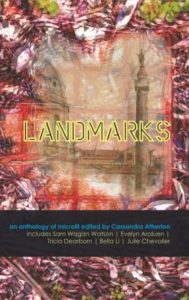 This week we talk to prize-winning poet and short story writer, Tricia Dearborn, about her short story ‘Dancing with the Machine’ which is published in Landmarks – the latest anthology curated by Spineless Wonders. During this interview we discover her favourite Australian landscape, who inspires her writing and what inspired her latest micro-lit, ‘Dancing with the Machine.’
This week we talk to prize-winning poet and short story writer, Tricia Dearborn, about her short story ‘Dancing with the Machine’ which is published in Landmarks – the latest anthology curated by Spineless Wonders. During this interview we discover her favourite Australian landscape, who inspires her writing and what inspired her latest micro-lit, ‘Dancing with the Machine.’
Tell us about a landmark that is significant to you
I grew up in Bathurst but travelled to Sydney with Mum and my siblings every school holidays, usually to stay at Grannie’s – my mother’s mother’s – house. (Grandpa was there too, but more of a background figure.) It was a magical place for me. I thought of it just yesterday because I walked past a shop that smelled of mothballs. For me as a child, that smell meant Grannie’s, and I loved it. I often use my life in my work, and I find childhood a potent area to mine. I wrote a poem about that house (‘Sanctuary’), then discovered recently that it had been demolished. I felt glad I’d written about it while it still physically existed.
What inspired you to write ‘Dancing with the Machine’?
The direct inspiration for ‘Dancing with the machine’ was finding a lump in my breast and having to go for the full-on check-up – manual exam, mammogram, needle biopsy – with the excellent result that nothing was wrong (I think it was some kind of cyst). I remember being positioned for the mammogram, with my arm across a part of the machine at shoulder level and my head turned away from it, and it striking me how similar it was to a dance pose.
How do you find the experience of writing to a theme?
I don’t know that I’ve ever written to a theme – I tend to have to write whatever I feel compelled to write at the time. When a themed opportunity comes along it’s a matter of trawling through my work – both finished and in progress – to see if I have anything appropriate. (Actually, I did write a poem on the theme of ‘Easter’ when I was in second grade, a juicy little number about the Crucifixion.)

Describe your writing space
Our block of flats was built in 1936 and my writing room would have been the sunroom. It’s the hottest room in summer and the coldest in winter (when Sydney had that incredible nearly 46 degree day a few years back, I worked till noon and then had to retire to cooler parts of the house because it felt like my brain was boiling in my skull). I don’t mind, because it’s light and airy and feels spacious, with a nice high ceiling and room for what I need: a desk that I made by painting a door red and laying it across two filing cabinets; two tall bookcases and a small one that contains my favourite childhood books; a sturdy work table with dents and discolorations and a lot of character; a colourful kilim, some art on the walls, and a corkboard with the list I use to track invitations, submissions and so on.
Tell us about a writer or work that has inspired you as a writer
Virginia Woolf inspires me as a writer (and a person). A quote I like from her diary is ‘I am I: and I must follow that furrow, not copy another.’ When I was reading her diaries the first time, I got nearly to the end of volume 1 and raced to Gleebooks just before closing time to buy volume 2 – I couldn’t stand the thought of not having one on the go; I used to keep the current one in bed with me while I slept. I’d also like to mention an anthology that inspired me back in the nineties, called The Writer on Her Work. It’s a two-volume anthology and volume 2 – the first one I read and my favourite of the two – contains intriguing and illuminating essays on writing by people like Margaret Atwood, Elizabeth Jolley, Ursula Le Guin. There was something very empowering about that unashamed ‘the writer … she’.
Tricia Dearborn is a prize-winning poet and short story writer. Her work has been widely published in literary journals including Meanjin, Southerly, Island and Overland, and in anthologies such as Contemporary Australian Poetry, Australian Poetry since 1788, The Best Australian Poems 2012 and 2010, and Australian Love Poems. She is on the editorial board of Plumwood Mountain, an online journal of ecopoetry and ecopoetics, and was poetry editor for the February 2016 edition. She has degrees in biochemistry and arts. Her most recent collection of poetry is The Ringing World, published by Puncher & Wattmann in 2012.
Feature image via Pexels.com

